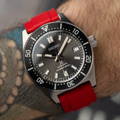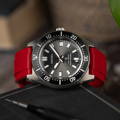-
We're here to help
- +33664042975
- info@zealande.com
WHERE ARE SEIKO WATCHES MADE?
Seiko, the watch brand everyone loves and appreciates, is so well known across the globe for their relatively inexpensive yet iconic designs. From their famous divers to their dressy Presage line to their GMT’s, it is without a doubt a watch you can always pick and wear and enjoy. Seiko has not and will not try to beat out their Swiss watchmaking competition, however what they offer is excellent value for money and therefore usually most people first watch. Despite their impressive brand recognition and reach many people still don't know where Seiko watches are made and where the brand originated from. Today we are going to delve into a brief history of Seiko and show you where Seiko Watches are made in 2024.

Seiko's journey began in 1881 when Kintaro Hattori opened a small watch shop in the heart of Japan and one of the busiest cities in the world, Tokyo. Since then, the company has evolved into a global powerhouse, producing a diverse range of timepieces, from affordable quartz watches to high-end mechanical marvels. Since Seiko produced the first commercial quartz watch in 1969 Seiko has established manufacturing facilities in various locations worldwide to meet the demands of its discerning clientele.
Being a Japanese watch brand, it should come as no surprise that Seiko’s primary production hub for Seiko watches is Japan, where the brand's legacy originated. Seiko's Japanese-made watches are synonymous with exceptional craftsmanship, attention to detail, and technological innovation given the value of their watches. The brand's prestigious Grand Seiko line, renowned for its ultra high-quality mechanical movements and exquisite finishing, is predominantly manufactured in Japan as well. Skilled artisans meticulously assemble each component, ensuring that every timepiece meets Seiko's stringent standards.

Source : Time & TIde

Source : Time & TIde
However, Seiko could not simply produce all their watches in Japan with the demand being so high. For context back in 1938 Seiko were making around 1.2 million watches a year making them one of the highest producing watchmakers of the time. Throughout the 1990s and early 2000s Seiko produced staggering volumes of movements, their production went from 90 million units in 1992 to an average of 351 million units from 2000 to 2008. Today in more modern times, Seiko produces around 5 million watches a year, however what is interesting is the number of movements Seiko makes can be around 50 million. Whilst this seems almost unbelievably high, you need to remember that hundreds of other smaller watch brands all buy their movements form Seiko because they can manufacture reliable and accurate movements quickly.
Products featured in the article
In addition to Japan, Seiko has expanded its manufacturing operations and production facilities to other countries, leveraging local expertise and resources. For instance, Seiko has production facilities in Malaysia, where it manufactures a range of timepieces, including entry-level quartz watches and mid-range mechanical models. The Malaysian facilities uphold Seiko's commitment to quality while catering to different market segments and no doubt cost Seiko less to have them produced there.

Source : Oracle Time
Seiko didn’t stop there, they also have a large presence in China, where it produces a portion of its watches to cater to the growing demand in the region. While some watch enthusiasts may raise concerns about quality control in manufacturing facilities outside Japan, Seiko maintains strict oversight to ensure that all watches, regardless of their production location, adhere to the brand's exacting standards.

Source : Watch Gecko
It's worth noting that Seiko's approach to manufacturing is not solely based on geographical considerations. The brand emphasises a philosophy of "monozukuri," which translates to "the art of making things." This philosophy embodies Seiko's dedication to craftsmanship, innovation, and continuous improvement, regardless of where its watches are produced. Each watch undergoes rigorous testing and inspection to guarantee precision, reliability, and longevity. Moreover, Seiko remains committed to sustainability and ethical practices across its global supply chain. The brand prioritises responsible sourcing of materials and environmentally friendly manufacturing processes to minimise its ecological footprint. By having more production facilities across the globe, they can reduce both shipping time and their carbon footprint which is nice to see that Seiko cares about producing watches sustainably..
Seiko makes excellent watches; however, it is only natural that watches at the lower price point have certain elements that could be improved upon. The main issue with most Seiko watches that people tend to have an issue with is their cheaper bracelets, but do not let this deter you from purchasing a Seiko. ZEALANDE makes a perfectly fitted high-quality rubber strap for the Seiko Presage and the universal straps make for an excellent fit for any of Seiko’s models. Whether it’s to wear your Seiko 5 on a nicely complimenting sporty strap or to make the ZEALANDE rubber strap make the dial on your Presage pop they’ve got it all for you.

In conclusion, the question of where Seiko watches are made reveals a story of innovation, craftsmanship, and global collaboration. While Japan remains the heart of Seiko's manufacturing heritage, the brand's presence extends across multiple countries, each contributing to its diverse range of timepieces. Whether crafted in Japan, Malaysia, China, or elsewhere, every Seiko watch embodies the brand's unwavering commitment to quality, precision, and excellence in watchmaking.

What’s most impressive is the sheer volume of watches and movement Seiko produces and how reliable they are, a scale of operation like never before seen within the watch world! It’s a watch that you can wear with pride and make many memories with and a Seiko can fit in any watch collection whether it is your first watch or a watch to sit next to your Omega, Patek Phillippe and Rolex.

